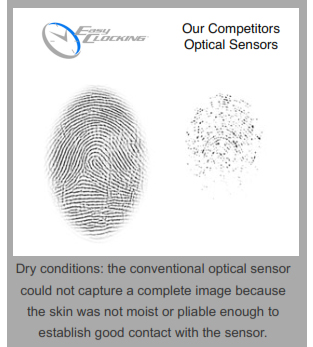| |
It’s hard to appreciate Easy Clocking’s solution without first understanding why conventional technologies have
so much trouble with dry fingers. Most optical sensors are configured to look for the presence or absence of
total internal reflectance (TIR), which is the phenomenon whereby the interface between glass and air acts like
a mirror at certain angles. The contact between the skin and the platen defeats the TIR, allowing those points
of contact between the finger and the sensor to be imaged. Thus, those points of contact must be complete
and unobscured to enable the conventional sensor to collect a fingerprint image. And with dry fingers, this is
simply not the case! Establishing firm and complete contact with the sensor is very difficult with dry fingers.
There is not enough moisture in the skin nor is the skin pliable enough to facilitate the contact necessary for
TIR imaging.
|

